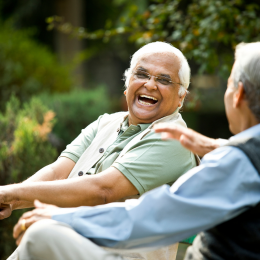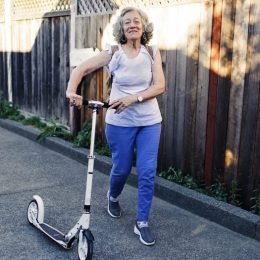How to Heal After the Loss of a Loved One
Grief experts share eight strategies for getting through a tough time with resilience.

Christy Monson spent decades helping others cope with grief. But when her husband of 54 years passed away earlier this year, she found herself in shock.
“I’ve assisted many people through the stages of grief and know them well,” says Monson, a marriage and family therapist and author of Becoming Free: A Woman’s Guide to Internal Strength. “And yet, when the love of my life died, I was still bewildered and in denial. I couldn’t believe he had passed away. ‘This isn’t happening to me,’ I thought.”
Since grief is unavoidable, it’s important to learn how to cope with these transitions effectively, says Sherry Cormier, Ph.D., a psychologist and author of Sweet Sorrow: Finding Enduring Wholeness After Loss and Grief.
Here, grief experts share helpful reminders and strategies to get you through tough times with resilience. Because you can make it through, even if there are moments when it seems impossible.
1. Give Yourself Time, Space, and Permission to Grieve
In psychology, there are five stages of grief, Monson explains:
- Denial: “This didn’t really happen.”
- Anger: “How could God do this to me?”
- Bargaining: “If only I had done things differently, this wouldn’t have happened.”
- Depression: “I’m going to feel sad the rest of my life.”
- Acceptance: “I have my precious memories so my loved one is with me forever.”
However, not everyone will cope the same way. It’s a myth that grief is linear, Cormier says. “Instead, it ebbs and flows much like the tides of an ocean, often overwhelming us yet also receding in intensity at times.”
“Everyone grieves differently, working through it at their own time,” adds Paul DePompo, Psy.D., a clinical psychologist in Newport Beach, California, who studies grief. “It’s not something you ‘get over,’ but rather something you learn to manage constructively.”
Your experience will not be the same as anyone else’s, so allow yourself time and space.
2. Take Good Care of Yourself
This is an important time to put yourself and your needs first, since healing from loss requires a great deal of energy, Cormier says. Practice self-care by eating nourishing foods, sleeping sufficiently every night, and getting some exercise, she suggests.
It may be hard to get moving when you’re feeling down, so start with small steps and build from there. Stand, stretch, or take a quick walk around your house or neighborhood. When you’re up for it, SilverSneakers classes are a great way to get active and connect with people. If you prefer exercising solo, check out this beginner’s guide to the gym.
“Nutrition, sleep, and exercise will go a long way in your healing, as they impact our brains and emotions and help you develop resilience,” Cormier says.
3. Surround Yourself with Family and Friends
“Sadness is helped most by ties to other people,” Cormier says. So nurturing your existing relationships with friends and family is one of the best things you can do when you’re grieving.
Having loved ones around also ensures you’re not alone to navigate the days immediately after a loss. Right after her husband died, Monson was in a daze. “I was unable to think or act to do the things necessary at the time,” she says. “Our son came to help me take it one step at a time until I was functioning again. I couldn’t have done it alone.”
It’s also never too late to forge new bonds. Consider joining a support group, signing up for a book club, participating in gym or yoga classes, volunteering at your local community center or place of worship, or simply inviting a neighbor over for a cup of coffee. As feelings of connection increase, sadness often decreases.
4. Adopt Daily Mindfulness Practices
After Monson’s husband died, she used the same techniques she recommends to clients to work through it. “These routines can greatly help reduce panic and anxiety,” she says. Here are her top four suggestions.
Practice deep breathing. Lie flat on the floor or sit in a chair, and place one hand on your stomach and the other on your chest. Begin breathing, concentrating on moving the hand on your stomach while keeping the hand on your chest still. On each exhale, concentrate on squeezing your abs to force out the air. This will help you learn to breathe with your diaphragm—a large muscle between your chest and digestive organs—not just your chest. Perform this exercise for one minute at least twice a day. See more simple but powerful breathing techniques.
Meditate daily. Meditation is much easier than most people think—and can quickly bring you comfort. There are plenty of apps that can help you get started, including Headspace (available on the App Store and Google Play), Calm (App Store and Google Play), and The Mindfulness App (App Store and Google Play), or you can try this five-minute daily meditation from 2017 SilverSneakers Instructor of the Year Terecita “Ti” Blair.
Be in the moment. If meditation’s not for you, or you simply want an additional daily mindfulness practice, do this: Sit quietly, observe your arms resting on the chair. Be aware of your toes. Notice the rest of your body. Clear your mind and focus on the moment. It’s a simple but powerful practice to calm your thoughts and help you feel grounded and in control. You can do this whenever you feel overwhelmed—anytime, anywhere.
Try guided imagery. Get comfortable and relax. Breathe deeply, and slowly count to 10 as you picture yourself climbing a set of stairs to come to a safe place that is personal to you. Imagine your loved one in this place, and talk with him or her about the death and separation. Say how you feel. Monson used this guided imagery practice often. “As I relaxed in a chair, I pictured myself walking along the beach,” she recalls. “I could see my husband with me, and we discussed what was happening. He gave me his feedback about our problems. Whenever I am lonely or miss him, I repeat this process.”
5. Stay Curious
“Sadness and curiosity are incompatible,” Cormier says. “The greater your sense of curiosity, the easier the healing process will be, so do whatever it takes to develop and enhance your curiosity.”
Some suggestions from Cormier: Take a class at your local community center or college, spend time searching on Google, listen to TED talks and podcasts, join a travel group to visit a new place, write stories, or make art. There are no rules about what you can or can’t do—anything that involves learning something new or makes you question something is a great option.
Taking breaks from grief and finding distractions is important too, Cormier says. “Watch a funny show, go to a comedy club, or see a comedy in the theater,” she suggests. “Laughter is just as healing as tears.”
6. Try to Find Meaning in the Loss
Grief can cause you to question, “What’s the point?” And then you can go down a rabbit hole if you get too existential, DePompo says.
Subscribe to our newsletter
It's quick and easy. You could be one of the 13 million people who are eligible.
Already a member? Click to discover our 15,000+ participating locations.
Follow Us
“If you’re having trouble finding meaning in the loss, allow the focus to be on the life they lived and how special of an opportunity that was, without ruminating on the end of it,” he says.
Also, remember that the bond you and your loved one shared is not gone, DePompo adds. It has been severed by the loss, but now needs to be reattached in a new way. This may mean taking on something—like a hobby, tradition, or other things they enjoyed—on their behalf and dedicating this time to connecting your thoughts with them, he explains.
“They can live on through you, and you can spread that love into the world on their behalf,” DePompo says.
7. Decide What the Next Stage of Your Life Might Look Like
“Take some time during your grieving process to plan what you want the next stage of your life to bring,” Monson suggests. If your whole life has been tied up with your loved one, for example, the grieving process can be coupled with introspection and self-growth.
For Monson, this new stage of her life is still full of activity. “I’m involved in work at the community college, my writing groups, and religious activities, as well as my family,” Monson says. “While my life is sad and somewhat lonely right now, I have outside interests that I’m involved in that help bridge the gap.”
To help you start thinking about this, ask yourself: What parts of our life together would I like to continue, and what new things might I try on my own? Jot down your ideas. You don’t have to stick to this list, but the mere act of writing down options can help you see what the future might hold and bring comfort.
8. Seek Help If Feelings of Grief Are Becoming More Intense
About 10 percent of people with loss suffer from “complicated grief,” which is intense, persistent grief that does not heal or improve over the span of several years following a significant loss, Cormier says.
Complicated or prolonged grief can raise your risk for developing both physical and emotional disorders so getting treatment is very important. If it’s been more than one or two years and your feelings of grief are increasing, the first step is to talk to your primary care physician. He or she may be able to connect you with the support you need.
If you experience other symptoms—like changes in sleep, appetite, or pain that are interfering with your life—check in with your doctor sooner. And if you have thoughts of wanting to die or harm yourself, seek professional help immediately, or call the National Suicide Prevention Lifeline at 1-800-273-8255.
Take Your Favorite SilverSneakers Classes Online!
SilverSneakers members can access live fitness classes and wellness workshops through SilverSneakers LIVE. See the latest schedule and RSVP for classes here.
Not a member? If you have a Medicare Plan, it may include SilverSneakers—at no additional cost. Check your eligibility instantly here.





